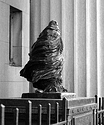Bill Burk
Subscriber
- Joined
- Feb 9, 2010
- Messages
- 9,427
- Format
- 4x5 Format
As Michael pointed out, there is an interesting thread that gives practical advice towards this goal.
Dark print vs bright print.... what's going on?
I found myself significantly moved by one post by Doremus Scudder
(there was a url link here which no longer exists)
Like Bob Carnie, I make 3 final prints each time I print a negative. I agree with Bob, you can mentally accommodate for dry-down. I look at the toned and dry prints side-by-side in various lighting conditions (inside terrible light for first impression, outside daylight for toning color, viewing station for standard view). I look for differences between prints that are supposedly the same. I am most confident of my own work when I can see differences and still call all the prints acceptable. When I prefer one print over the other, then I know what direction to go next time I find myself in a similar situation. Since I am a hobbyist, instead of printing three more times, I take mental note to do better next time and move on.
Bob, I can't for the life of me find your list of printing tips I hoped you would repost here. (Searching for duck's tail doesn't seem to pull it up).
Dark print vs bright print.... what's going on?
I found myself significantly moved by one post by Doremus Scudder
(there was a url link here which no longer exists)
Like Bob Carnie, I make 3 final prints each time I print a negative. I agree with Bob, you can mentally accommodate for dry-down. I look at the toned and dry prints side-by-side in various lighting conditions (inside terrible light for first impression, outside daylight for toning color, viewing station for standard view). I look for differences between prints that are supposedly the same. I am most confident of my own work when I can see differences and still call all the prints acceptable. When I prefer one print over the other, then I know what direction to go next time I find myself in a similar situation. Since I am a hobbyist, instead of printing three more times, I take mental note to do better next time and move on.
Bob, I can't for the life of me find your list of printing tips I hoped you would repost here. (Searching for duck's tail doesn't seem to pull it up).





 And when a print is perfect you just know it. Sometimes it's easier than others, and sometimes it just never seems right, even after 3 or 4 sessions trying to re-work a negative. I am hoping over time that my skills will get better and that feeling of getting to a point of being happy with a print will come more often.
And when a print is perfect you just know it. Sometimes it's easier than others, and sometimes it just never seems right, even after 3 or 4 sessions trying to re-work a negative. I am hoping over time that my skills will get better and that feeling of getting to a point of being happy with a print will come more often.